Waradiel* Season
Tales of our original inhabitants using dolphins to herd mullet and tailor for capture and their kinship with the land and its seas also tell of how the Guringai read the seasons through the appearance of plant’s flowers, shifts in the winds and even certain clouds appearing, in their due season. The return of giant schools of sea mullet, as part of these seasonal shifts, was an event for indigenous peoples that also saved the settlers sent to this place and became part of their calendar of events once this wisdom was understood.
The beginning of February and the flowering of the white paperbark tree (some sources state tea tree or coastal wattle), used to signify, along with cooler winds from the south and certain cumulus clouds, the beginning of the mullet runs and fish season to the Guringai peoples of Pittwater. “The appearance of the ‘golden yellow flowers’ of the Kai’arrewan (Acacia binervia), for example, indicated that fish would be running in the rivers, ‘and on moonless nights the tidal rivers will echo with the delighted cries of the People as they catch the delicious prawns which inhabit the shallows’.16 In contrast, the flowering of Burringoa (Eucalyptus tereticornis), which signifies the coming of cold weather, indicates ‘that it is a time when the people are not permitted to eat shellfish such as prawns, crabs, yabbies, mussels, pipis, lobsters or periwinkles’. The buds of the waratah and first appearances of flying foxes in the skies indicate the lifting of these restrictions, and ‘feasting on the beaches and river banks occurs’.” (Roberts. May 2010)
This Mullet season could run until September although some sources state these fish were smoked or salt-dried by indigenous peoples to last through winter months when fish were not so plentiful (other sources state winter was also a good fishing season for other types of fish). The fish runnings were also communal celebrations where whole tribes would gather together to harvest the fish. Part of this event’s celebration was to cook and eat the produce of the sea where and when it was caught. This practice was part of the culture of looking after the land and according it the respect due: One of the reasons for cooking fish where and when it was caught was to return the remains to Country and show respect for Country. (Roberts. May 2010)
Mullet inundated Narrabeen lake; Narrabeen: It abounds with the fish called mullet, which are excellent, and they are caught in great numbers by means of nets. William Romaine Govett, Saturday Magazine, Vol 9, 1836. Narrabeen remained a camp and feasting ground for our original inhabitants until around the 1950.: (See Peter Read, 'Aboriginal settlement Narrabeen Lagoon', Dictionary of Sydney, 2011)
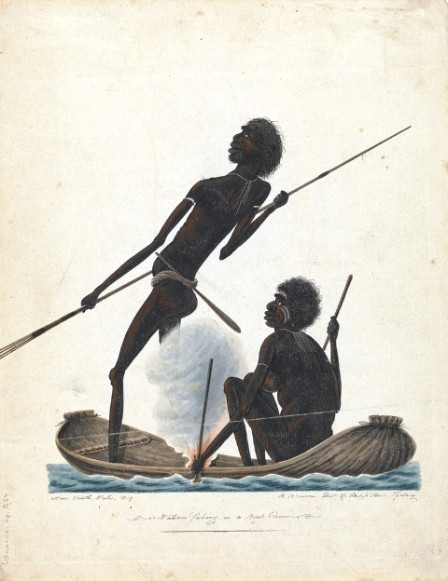
Above: Natives fishing in a bark canoe. (Titled beneath image). Inscribed lower left `New South Wales 1819'; by Richard. Browne, 27 Philip Street Sydney. Image No: a 4911001h, courtesy State Library of NSW
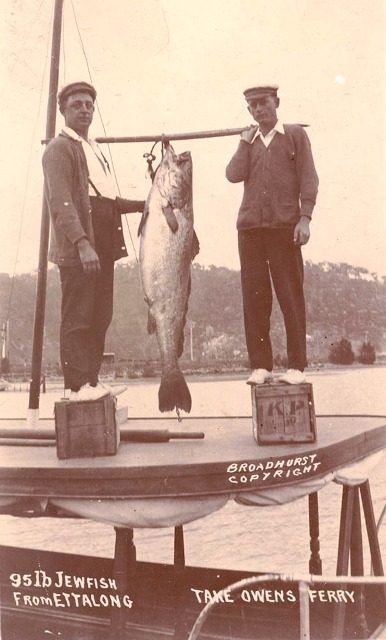
Mullet also filled Pittwater’s estuary and moved up the Hawkesbury. In March 1788, Governor Phillip, whilst on his explorations of our area, camped on a beach, then named it Bradley’s Beach after second in command, which is part of Dangar Island. Phillip named this isle Mullet Island after making a substantial catch offshore and the amounts of mullet in the river. Prior to Europeans this island was known as a birthing island for women. The Hawkesbury’s Aboriginal name was and is Deerubbin and is said to mean 'wide deep water.' Some descendants of these peoples still residing on the Central Coast prefer to be called by this name and state it is also the name of their tribe.
The Mullet Tide was a saviour for early settlers and some indication of how big these schools of fish were: In the early days of the colony, during the years 1789 and 1790, it would have been a matter of starvation for the people had not the mullet come to the rescue. These fish are just as plentiful this year as they were 100 years ago. It is narrated in our early records: - “There were 1030 persons who received, through one haul of fish, enough to serve rations for the day.” In another instance it is stated: - “So great was the quantity of fish that 2lb weight was given to everyone three times a week in addition to ordinary rations.” And again; - “4000 fish were taken in two hauls, each fish averaging 5lb weight.”
FISHING FOR THE SEA MULLET. (1887, May 4). The Sydney Morning Herald (NSW : 1842 - 1954), p. 10. Retrieved from http://nla.gov.au/nla.news-article28348177
Left: Broadhurst Image 1052066h, circa 1900. Below: Inscription on back of photo reads: [sic] "This is Wal and Les with a load of sea mullet we caught in Boambee Creek. This is only a few of the haul of over 3.5 tons." - Boambee, NSW, At Work and Play - bcp_01670, both Courtesy of State Library of NSW
February’s Mullet Run in the Ancient Schnapper Grounds (waters): It might be taken for granted that every variety of fish has its season, but that it is hardly safe to take anything for granted ; and so wisdom is wooed on this point, and it is made known by result, that there is a special season for mullet, and that season having set in about the beginning of February, (Sly and Mileswater being the fishermen who brought in the first glut about that time,) is now, and has for a fortnight been at its height of productiveness-the supplies of mullet to the two stations averaging about twenty- five bushels daily. But it appears that nil other descriptions of edible fish are in season through-out the year, and are only more abundant at one period than at another. The most abundant varieties during the current season, are mullet and whiting. The price took on at 11s. per bushel ; supplies increased, and it dropped to 10s. Whiting being, with guard fish, an esteemed sort, maintains its better price throughout the year but mullet at length comes very low, and the retailer can afford a good sized one, a foot long ,and fit for eating, for 4d. at the present time. When the fish is large, it is given out to him as it is received-by tho dozen, and not by the bushel
Lobsters (alias Crayfish) usually come in on the Monday, from Broken Bay, in quantities of about fifteen dozens. A good lobster (or cray fish) is said to be worth 1s. We are not Afrikanders, buying them for 3d. out of Table Bay, but in our amiable weakness we think it a bargain to get a good one for 4s. 6d. (46 cents)
SCHNAPPER has no circumscribed empire, but ranges the coast and penetrates each creek. There is some uncertainty of finding schnappers, however, and when found they are mostly in shoals. A few dozens may occasionally be caught outside the Heads, and within near the lighthouse, but in cooler weather they are conveyed eighteen miles, from Broken Bay. Eighty dozens of schnappers were brought in from that bay about two months ago, but owing to the want of a means of preserving them the bulk of them was lost to the fishermen, for it was not in the power of the retailers to dispose of such a stock*. The last fort-night has yielded a few good draughts of schnappers.
SYDNEY FISH SUPPLIES. (1857, April 14). The Sydney Morning Herald (NSW : 1842 - 1954), p. 2. Retrieved from http://nla.gov.au/nla.news-article12994194
Watkin Tench, part of the First Fleet, recorded the following method of preparing fish:
'by throwing the fish, exactly in the state in which it came from the water, on the fire. When it has become a little warmed they take it off, rub away the scales, and then peal off with their teeth the surface, which they find done, and eat. Now, and not before, they gut it; but if the fish be a mullet, or any other which has a fatty substance about the intestines, they carefully guard that part, and esteem it a delicacy. The cooking is now completed, by the remaining part being laid on the fire until it be sufficiently done' (Tench 1793).
The mullet were coming to spawn; NATURALIST SOCIETY.
At a meeting of the Naturalist. Society, New South Wales last evening the president , (Mr. David G Stead) gave a short address in the course of which he said that of the 1300 known species of Australian fish 60 were found In New South Wales waters. By means of a series of lantern slides Mr Stead Illustrated the growth of various species and in referring to the spawning of sea mullet, mentioned that he had estimated one mullet which he examined in spawning season contained 8,000,000 eggs.
NATURALIST SOCIETY. (1930, February 5). The Sydney Morning Herald (NSW : 1842 - 1954), p. 16. Retrieved from http://nla.gov.au/nla.news-article16623542
There are rock carvings in our area of fish which indicate the reverence and part of ceremonial practices fish tides held for local indigenous peoples. Some of these are beginning to deteriorate as these ceremonies, and the re-carving of the grooves as part of this, no longer are performed, again in their due season. There is some indication these sacred rituals were in accordance with bringing or ‘calling’ the fish in. Unfortunately the songs that were sung in Pittwater we will never hear.
ABORIGINAL CARVINGS AT PALM BEACH. 'TO THE EDITOR OF THE HERALD. Sir,-I enclose a copy of some aboriginal carvings at Palm Beach, which should be of Interest to the public The outline drawings represent two kinds of fish and a man, cut on a flat rock; on the hill between Sand Point, Pittwater, and Cabbage Tree Boat Harbour, Palm Beach, Barranjoey. The fish measures 22ft, the man 6ft 6in, and the smaller fish 6ft long. They have exceptionally good outlines, and are better shaped than any others yet recovered The Hawkesbury sandstones, by reason of their comparative softness, offered exceptional facilities to the coastal tribes of our aborigines to display their art In pictorial drawings, as there are many in the -Port Jackson and Hawkesbury districts It is not known what age these carvings can be, but many hundreds of years must have elapsed since they were made The drawings have only Just been discovered by Architect H A.Wilshire and Stonemason J Booth, who were looking for building stone on the company's property at Palm Beach The company has decided to preserve the carvings for all time.
I am, etc.,
E. E. G. de GYULAY, Secretary,
The Barrenjoey Company.
ABORIGINAL CARVINGS AT PALM BEACH. (1918, January 1). The Sydney Morning Herald (NSW : 1842 - 1954), p. 3. Retrieved from http://nla.gov.au/nla.news-article15781235
*waradiel ‘large mullet’ is from Cadigal language (Sydney Basin) as we could not determine the correct name given to mullet by the Guringai peoples; apologies for this. The mullet is Mugil cephalus Sea Mullet
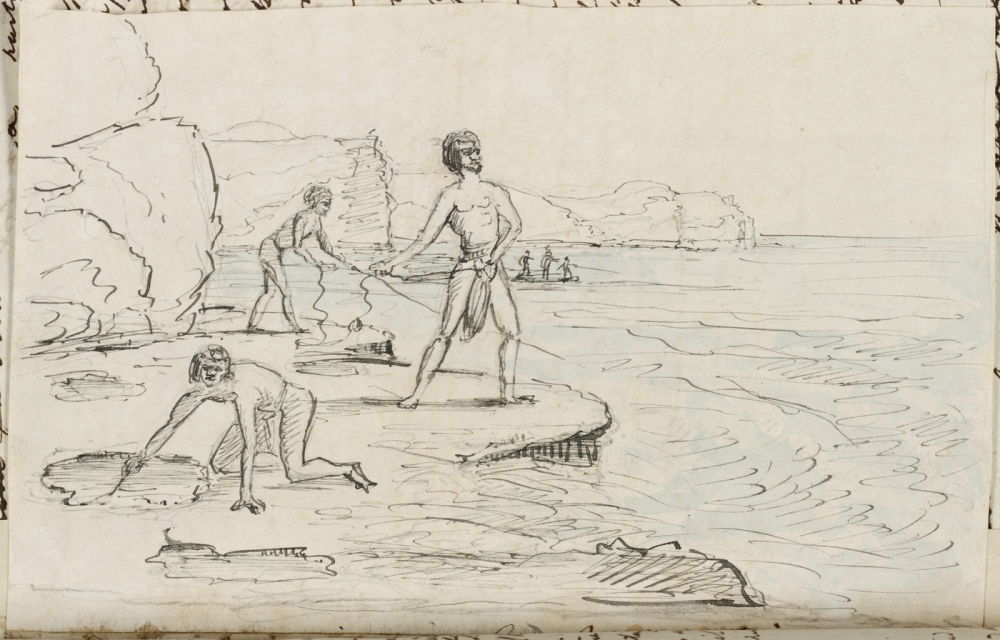
William Govett notes and sketches taken during a surveying Expedition in N. South Wales and Blue Mountains Road by William Govett on staff of Major Mitchell, Surveyor General of New South Wales, Between pp. 36-37 [Aborigines fishing from a canoe], Image No: a2424014. William Romaine Govett was surveying Pittwater in January-February 1829.
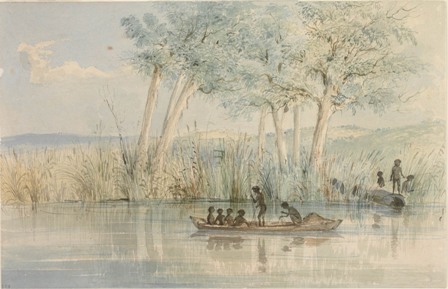
Australian aborigines, their implements & weapons, c.1845 / sketched by Samuel Thomas Gill, Image No a955001
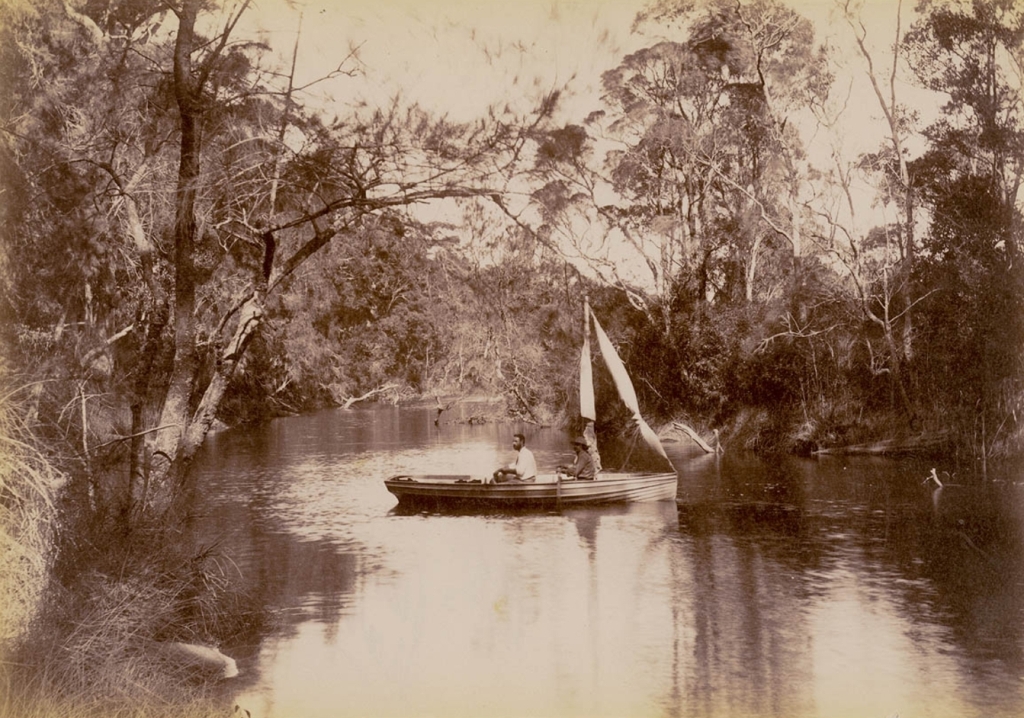
Aboriginal men in boat on Narrabeen lagoon, c 1905, Digital Order No. a116488, all courtesy State Library of NSW
Alex Roberts, with input from Kath Schilling. May 2010. Aboriginal Women’s Fishing in New South Wales A thematic history. mullet pages 12, 15, 16, 26, 27, 28. Published by: Department of Environment, Climate Change and Water NSW 59–61 Goulburn Street PO Box A290 Sydney South 1232
And at: http://www.environment.nsw.gov.au/resources/cultureheritage/10131abwfish.pdf
SOME OBSERVATIONS ON THE MATERIAL CULTURE OF ABORIGINAL FISHING IN THE MORETON BAY AREA: IMPLICATIONS FOR ARCHBIOLOGY. IA N WALTERS Anthropology & Sociology , University of Queensland
At: https://www.library.uq.edu.au/ojs/index.php/qar/article/viewFile/307/349
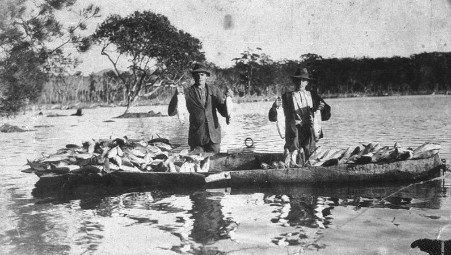 The following information comes from the booklet, and has been endorsed by the local Darug communities.
The following information comes from the booklet, and has been endorsed by the local Darug communities.
The seasonal cycles of plants dictated Darug people’s movement around their territories. Their staple diet was the plentiful edible lily tuber that they replanted each season in the rich alluvial river flats around the Hawkesbury-Nepean (Deerubin) River. Replanting and fire management ensured the seeds and root-stock continued to provide food for the family as they passed through the floodplain and lagoon country when the mullet were running.
From; http://www.rbgsyd.nsw.gov.au/plant_info/aboriginal_bush_foods
Aboriginal settlement Narrabeen Lagoon
by Peter Read, 2011
Aboriginal settlement Narrabeen Lagoon
The camp site at Narrabeen Lagoon was the last community Aboriginal town camp to survive in the northern Sydney suburbs. Probably, before the British invasion, Narrabeen Lagoon was one of the many coastal occupation sites offering seasonal shelter, fish and wetland resources. Until perhaps 1850, the western end of the lake was a community and secular living area standing in relation to the higher country of the Collaroy plateau above. This higher and less accessible country was used for ceremonial and educational purposes by the Gai-mariagal. Dennis Foley, a Gai-mariagal (Camaraigal) descendant, describes the area as 'the heart of our world'. [1]
More at:
References
Interview with Dennis Foley, conducted by Peter Read, June 2009, held in Aboriginal and Torres Strait Islander Data Archive, University of Technology, Sydney
Foley, Dennis, Repossession of our Spirit, Aboriginal History, Canberra, 2001
Read, Peter, Belonging, Cambridge University Press, Melbourne, 2000
'National Fitness Council', State Records NSW website, digital gallery, http://www.records.nsw.gov.au/state-archives/digital-gallery/our-sporting-heritage/national-fitness-council/images-1/11-19038.jpg/image_view_fullscreen
(NRS 10663) Notes
[1] Dennis Foley, Repossession of our Spirit, Aboriginal History, Canberra, 2001, p 47
While researching the commencement of the Waradiel Season we came across this and had to share it; seems strange that less then a hundred years ago people went Marlin fishing at our own Palm Beach:
BLACK MARLIN Caught off Palm Beach. Dr. D. G. Maitland yesterday afternoon landed a 1601b black marlin off Palm Beach. He was trolling from his cruiser Idler about a mile and a half from the shore and four miles south- east of Palm Beach, when the marlin, one of several he had sighted, first struck.
After playing the fish for 35 minutes, Dr. Maitland succeeded in getting it aboard the Idler. It turned the scale at 1601b. It is the first black marlin that Di. Maitland has caught and one of the few which have been caught .. as far north as Palm Beach so early in the season.
"My catch augurs well for the success of the angling competitions during the 150th Anniversary celebration?." Dr. Maitland said. "It is very encouraging to find black marlin in the Palm Beach waters. Generally at this time of the year they are only to be found around Bermagui."
BLACK MARLIN. (1937, December 29). The Sydney Morning Herald (NSW : 1842 - 1954), p. 11. Retrieved from http://nla.gov.au/nla.news-article17442404
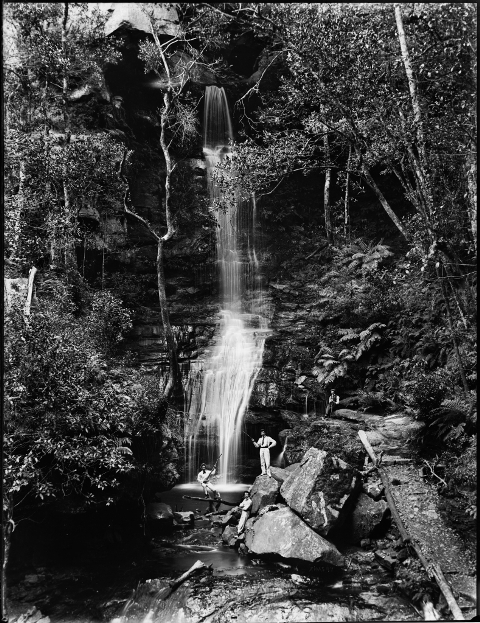
Three men fishing at the foot of a waterfall circa 1900, by Kerry and from Tyrell Collection, courtesy of Powerhouse Museum.
Waradiel* Season (Mullet Season) threads collected and collated by A J Guesdon, 2012